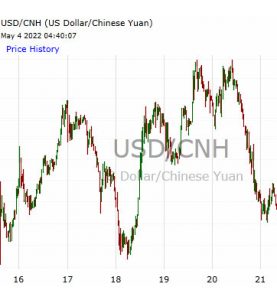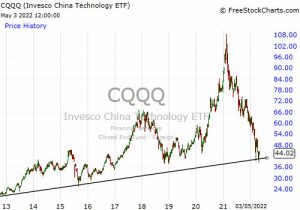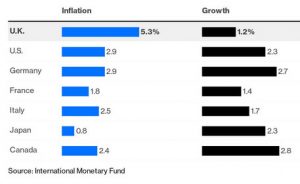Click Here for Printable Version
This difficult period for global bond and equity markets continued with little respite in April. The three big factors currently in play i.e. rising US (and thus global) interest rates, the war in Ukraine and Covid-19 in China, all delivered negative news flow.
The problem is that each of these difficult issues are impacting the three big economic blocs both equally and differently.
For Europe it is mainly the Russian war in Ukraine and the threat to the gas supplies that is the big issue; in the USA it is the Federal Reserve Bank scrambling to unwind it’s excessively generous Covid-19 stimulus in the face of rising inflation.
In China, however, it is Covid-19, with the two biggest manufacturing cities Shanghai and Shenzhen back in lock-down and Beijing undergoing mass testing.
For the markets the common theme is the interaction between interest rates and inflation. It is good news that that the decades of money printing and disruptively low interest rates now appear to be passing.
A return to “normal” cannot ultimately be a bad thing. However, it is the process of getting there, that brings short term risks.
Whilst big swings in share prices are never welcome, ultimately enhanced returns should make it all worthwhile for long term investors.
Inflation is a good thing for economies and holders of assets, such as houses and investment portfolios, just not too much and too quickly!
One very significant new development this month was the weakness of the Chinese currency, the yuan, against the US dollar.
China
As the world’s second largest economy, biggest exporter of manufactured goods and usually the fastest growing of the major economies, China matters.
With so much other negative news around the return of Covid 19 is not welcome. China has a zero-Covid policy and locally produced vaccines are not as effective as the Moderna or Astra Zeneca ones.
So as Omicron sweeps through the biggest cities the Chinese authorities have chosen to lock down. The direct economic impact is a reduction in manufacturing and thus exports. This is leading to further supply shortages, which is on top of the already disrupted supply chains to the US and Western Europe.
Companies from Apple to the all the major car manufacturers continue to suffer restricted production arising from component shortages. This is clearly impacting inflation and just at this already difficult time is not welcome. The other consequence is on oil prices as Chinese demand drops (good news) and also on the currency.
This first chart shows that the dollar has suddenly become very strong versus the yuan. This can be explained by the US central bank raising rates and ending money printing just as the Chinese do the opposite.
The immediate economic impact on Chinese shares is however, being masked by the Covid lock-downs.
The second chart shows just how far the big Chinese technology companies have fallen in value, not just by weakness in technology shares in general but also by regulatory crack-downs in China itself.
Companies such as Tencent, Alibaba, JD.com etc. are some of biggest in the world and rival the likes of Alphabet and Meta in scale. The Chinese sub index, shown here as the dollar priced ETF, has fallen by over 50% and is at an interesting support point.
Intriguingly, both Goldman Sachs and JP Morgan have turned positive on Chinese shares.
We also now know what happens to an economy when it emerges from Covid lockdowns.
Whilst the West is grappling with supply and labour shortages stimulating inflation, in the Far East this is simply not a problem.
For US consumers faced with inflation the prices of Chinese goods have suddenly become a lot cheaper.
Interestingly, for the world’s third largest economy Japan, the currency and Index charts look virtually the same as the above. The investment focus seems to be returning to the Far East.
Ukraine and Europe
In the mercenary world of investment not much has changed since the unexpected invasion.
Russian gas is still flowing to Europe and Russia has not technically defaulted on its national debt. Clearly, this is a very unpredictable situation. The EU is taking very small steps to phase out purchases of Russia oil by the end of the year, which does seem to be a classic “kick the can down the road”.
There is a desire to reduce dependence on Russian gas but the Germans are not keen to do anything that risks an immediate cut-off of gas supplies.
Germany needs time to build LNG terminals, storage and new pipelines and the Russians know this.
Russia is now demanding payment from Poland and Bulgaria in roubles for gas. They will, no doubt, do the same for Germany and soon.
If the Germans comply or fail to find a legal workaround they will be in default of EU sanctions. If they chose the moral option, then recession for Europe seems to be inevitable.
The Growth Outlook for 2023
These forecasts from the IMF for next year are unlikely to be accurate, there are just too many variables in play at present.
Nevertheless, they do represent the current “state of play” in this complex and difficult
economic time.
Crucially, US inflation is seen as coming rapidly back to normal. The big Wall St houses are looking for US inflation to end the 2022 close to 4%, if it does then then the Fed will have successfully engineered a “soft landing” and the markets should react positively.
The UK is in a difficult place with labour shortages holding back growth and a Chancellor that didn’t learn the lessons of George Osborne and has introduced tax increases just at the wrong time.
With China back in lock-down the current data is very volatile, the US surprisingly
recorded negative GDP growth in March, this was quickly discounted as a statistical freak.
Markets
The natural reaction of investors is (and should be) that rising inflation leads automatically to rising interest rates and thus slower economic growth and usually (because the Central Banks go too far) recession.
So far bond markets globally have fallen to reflect this fact and have returned to levels consistent with 2.5% inflation (the norm). This has led to the majority of equity markets
falling to “correction” levels e.g. the S&P 500 recently hitting the 15% Drawdown number, a level the big institutions start to feed money into.
The trillion dollar question is always was that the bottom….has all the bad news been priced into markets?
As ever we won’t know until enough time has passed that, with benefit of hindsight, we can say it was. The ultimate key will be inflation, it is not just the trend (is it up or down) it is also the rate of change, is it slowing?
Much will depend on the oil price, so far the Saudis have not upped production significantly and neither have the US shale producers. There remain stresses in the oil market, shortage of tankers, wrong oil in the wrong place and worryingly very tight supply of diesel in both Europe and the US.
The crude markets did though catch a break with China locking down, this as we all know will not be forever and there is a risk that as and when China reopens and starts manufacturing again oil prices might spike upwards.
Speculators do know though that oil is ultimately plentiful and Russian oil is still around, just few are brave enough to buy it.
So the probability of some more short term shocks to inflation is high. Against that, for the US consumer, imports are getting a whole lot cheaper, if you can get them. The queue of ships waiting unload in US ports remains stubbornly high.
Post Covid estimates from Morgan Stanley are that the US consumer has $1.6 trillion of extra spending power, in the UK the equivalent figure could be £470billion. These are huge numbers and with such high levels of employment and labour shortages the impact of a recession (not yet certain) is likely to be relatively small.
Risk is clearly elevated, there are just too many variables in play at present, any one of which could easily tip the Western world into recession and equities will then have to reprice to reflect this fact.
As investors it is important to see such events as rare and also as long term opportunities.
Which is why the 15% levels are very important, the big investment houses can’t buy in
a crash, they simply cannot move enough money to do so, so once the this level is reached, they switch to “buy on the dip” mode.
They are prepared to take short term pain for long term gain. There is lots going on, as ever it will pass, but it might be a few months yet before a clearer picture emerges from this difficult and complex period for markets. Covid-19 restrictions ending in China will help as would inflation stabilising.
May 2022
Click Here for Printable Version
This information is not intended to be personal financial advice and is for general information only. Past performance is not a reliable indicator of future results.






